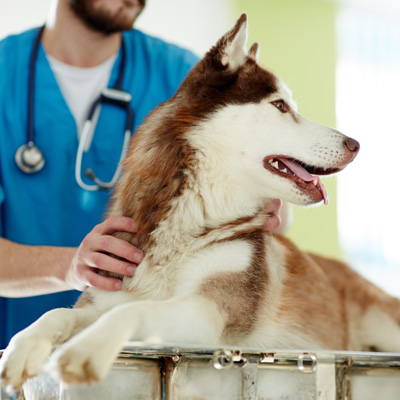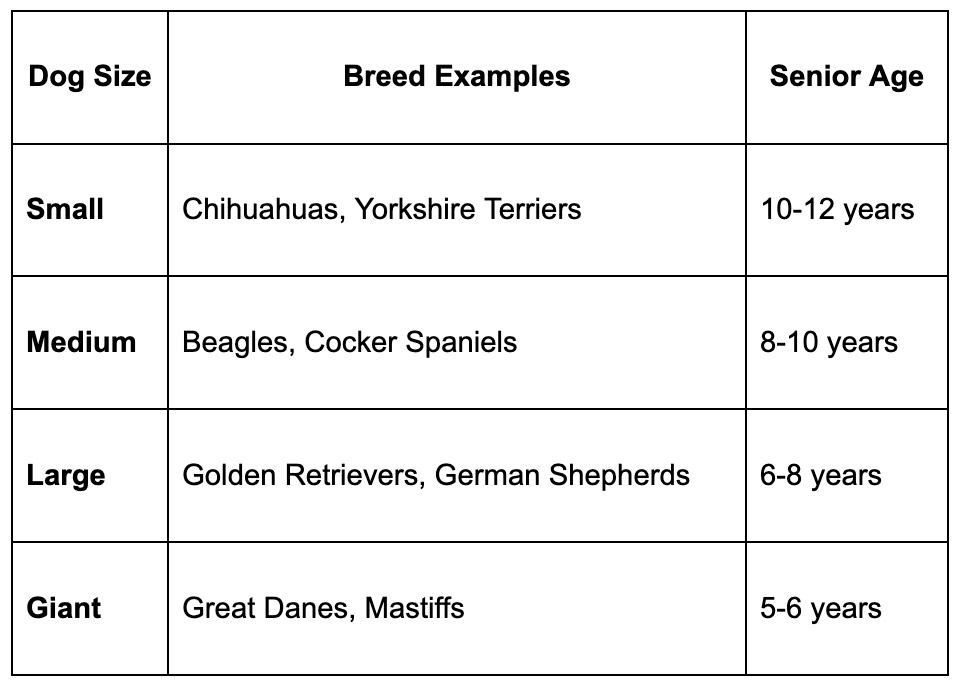Last Updated on 2 months by Dr Alisha Barnes

Watching your furry best friend enter their golden years can stir up a mix of emotions. One day they’re chasing tennis balls with boundless energy, and the next, you notice them hesitating before jumping onto the couch.
As an animal chiropractor who’s worked with hundreds of senior dogs at Tails Animal Chiropractic Care, we’ve seen firsthand how the right care approach can help your aging companion thrive, not just survive. With the right combination of veterinary care, animal chiropractic support, and loving attention at home, your senior dog can enjoy their golden years with dignity and joy.
See more: 5 Ways to help your Senior Dog be as happy and healthy as possible
Understanding Your Dog’s Aging Journey
Before diving into care tips, let’s understand when dogs officially become “seniors.” This varies significantly by size and breed:

Early Warning Signs to Watch For:
- Taking longer to get up from their bed
- Reluctance to climb stairs or jump
- Less enthusiasm for evening walks
- Vision changes and cloudy eyes
- Reduced energy levels
- Joint stiffness, especially in mornings
Why does proactive care matter so much during this stage?
According to research published in the Journal of Veterinary Internal Medicine by Dr. Sarah Mitchell (2023), dogs who receive comprehensive senior care – including regular veterinary checkups, appropriate nutrition, and complementary therapies like animal chiropractic – show significantly better mobility scores and quality of life measures compared to those receiving basic care alone.
1. Prioritize Regular Veterinary and Chiropractic Checkups
The foundation of excellent senior dog care starts with consistent professional oversight. This increased frequency allows for early detection of common age-related conditions like kidney disease, heart problems, and diabetes.
What Happens During a Senior Wellness Exam:
- Comprehensive blood work – checking organ function
- Joint mobility assessment – identifying arthritis or stiffness
- Cognitive function evaluation – screening for dementia
- Pain management discussion – updating comfort strategies
- Vaccination protocol review – adjusting based on lifestyle
This is also the perfect time to introduce animal chiropractic assessments. Many pet parents don’t realize that senior dog chiropractic care can address issues that traditional veterinary medicine might not fully resolve.
Common Conditions We Treat:
- Arthritis and joint stiffness
- Intervertebral disc disease (IVDD)
- Postural decline and muscle imbalances
- Hip dysplasia complications
“Combining traditional veterinary care with animal chiropractic treatments showed a 65% improvement in mobility scores among senior dogs with musculoskeletal conditions.” – Dr. Jennifer Rodriguez, Veterinary Therapeutics (2024)
2. Nourish with Age-Appropriate Nutrition
Nutrition becomes increasingly critical as dogs age. Their metabolism slows down, digestive efficiency may decline, and their bodies require different nutrient profiles to maintain optimal health.
Key Ingredients to Prioritize:
- High-quality proteins (chicken, fish, lamb)
- Complex carbohydrates for sustained energy
- Healthy fats for coat and skin health
- Joint-supporting nutrients (glucosamine, chondroitin)
Ingredients to Avoid:
- Excessive fillers and by-products
- Artificial preservatives
- Known allergens or sensitivities
Game-Changing Supplements:

Weight Management Strategies:
- Feed smaller, more frequent meals
- Measure portions precisely
- Choose low-calorie, high-nutrition foods
- Incorporate gentle exercise
- Monitor body condition monthly
3. Keep Them Active Without Overdoing It
The key to maintaining aging dog mobility lies in finding the sweet spot between beneficial activity and harmful overexertion.
Slow Leash Walks
- Allow dogs to set their own pace
- Focus on consistency over distance
- Choose softer surfaces when possible
Swimming
- Provides resistance without joint stress
- Excellent cardiovascular workout
- Builds muscle strength safely
Gentle Stretching Routines
- Maintain flexibility and range of motion
- Can be done at home daily
- Helps prevent muscle stiffness
Watch for warning signs of pain or overexertion during exercise. Heavy panting that doesn’t resolve quickly, limping, reluctance to continue walking, or unusual stiffness afterward all indicate your dog may be pushing too hard. Adjust activities accordingly and consult your veterinary team if concerns persist.
4. Animal Chiropractic for Senior Dogs: A Natural Mobility Solution
Animal chiropractic care focuses on diagnosing and treating neuromuscular disorders through manual adjustment of spinal and extremity joints. For senior dogs, this therapy can be transformative in managing age-related mobility challenges.
Conditions that respond well to Chiropractic care:
- Arthritis – Reduces joint restriction and inflammation
- Hip Dysplasia – Improves pelvic alignment and function
- IVDD – Supports spinal health and nerve function
- Postural Misalignments – Corrects compensatory patterns
When looking for an animal chiropractor near me, ensure they hold proper certifications. Licensed veterinarians or human chiropractors must complete additional training through organizations like the American Veterinary Chiropractic Association (AVCA) to legally treat animals. This specialized training is crucial because animal anatomy and treatment approaches differ significantly from human chiropractic care.
5. Protect Cognitive and Emotional Wellness
Canine Cognitive Dysfunction (CCD), often called “doggie dementia”, affects up to 50% of dogs over 11 years old according to research by Dr. Lisa Patterson published in Veterinary Neurology Today (2024). Recognizing early signs helps you provide appropriate support and interventions.
Common symptoms include:
- Disorientation – Getting lost in familiar places
- Sleep Pattern Changes – Restless nights, excessive daytime sleeping
- House Soiling – Accidents despite being house-trained
- Social Changes – Reduced interaction with family
- Repetitive Behaviors – Pacing, excessive vocalization
Enrichment activities keep senior minds active and engaged. Snuffle mats encourage natural foraging behaviors, scent games tap into their powerful olfactory abilities, and interactive puzzle toys provide mental stimulation without physical strain. The key is choosing activities appropriate for your dog’s physical limitations while still challenging their cognitive abilities.
Emotional support becomes increasingly important as dogs age. Many seniors experience anxiety related to vision or hearing loss, cognitive changes, or physical discomfort. Maintaining consistent routines, providing comfort items like favorite blankets, and using calming techniques can help reduce stress.
6. Keep Teeth and Coats in Good Shape
Oral hygiene becomes increasingly challenging but more important as dogs age. Dental disease can lead to serious complications affecting the heart, liver, and kidneys.
Step-by-Step Brushing Guide:
- Start with gentle finger massage
- Introduce enzymatic toothpaste (never human toothpaste!)
- Use soft-bristled or finger brush
- Focus on outer tooth surfaces initially
- Gradually increase brushing time
Grooming becomes more delicate with fragile senior skin. Use gentle brushes and be extra careful around sensitive areas. Many older dogs develop skin conditions or lumps that require careful navigation during grooming sessions. Regular brushing helps you become familiar with your dog’s body, making it easier to identify new growths or changes early.
7. Create a Senior-Friendly Home Environment
Small modifications to your home environment can dramatically improve your senior dog’s quality of life.
- Non-slip rugs on smooth surfaces
- Ramps to replace stairs
- Night lights in hallways
- Orthopedic memory foam bed
- Elevated food and water bowls
- Extra blankets for warmth
Environmental consistency helps reduce stress and disorientation, especially important for dogs showing signs of cognitive dysfunction.
- Keep furniture in familiar places
- Maintain regular feeding schedules
- Avoid unnecessary layout changes
- Provide multiple water stations
8. Monitor Behavior, Pain, and Sleep Changes
Behavioral changes in senior dogs often signal underlying health issues that require attention. Confusion, excessive vocalization, pacing, or changes in social interaction patterns may indicate cognitive dysfunction, pain, or other medical conditions.
Pain signs in senior dogs can be subtle. Unlike humans, dogs don’t always vocalize discomfort. Instead, watch for changes like reluctance to move, grumbling when touched, excessive licking of joints, isolation from family activities, or changes in eating habits. These subtle signs often indicate your dog is experiencing discomfort that could benefit from intervention.
Sleep pattern changes are common but shouldn’t be ignored. Senior dogs may sleep more during the day and less at night, experience restless sleep, or have difficulty finding comfortable positions.
9. Prepare for the Final Chapter With Compassion
Remember that providing emotional support for yourself during this time is equally important. Grief counseling, pet loss support groups, and allowing yourself time to process difficult emotions are all part of caring for both you and your pet during this challenging period.
During this final chapter, comfort and love matter most. Your presence, gentle touch, and familiar voice provide immeasurable comfort to your aging companion.
Bonus: Holistic and Preventive Therapies for Longevity
Beyond traditional veterinary care and chiropractic treatments, several complementary therapies can enhance your senior dog’s comfort and mobility.
- Acupuncture helps manage pain and can improve energy levels.
- Laser therapy reduces inflammation and promotes healing.
- Massage therapy improves circulation and provides comfort through gentle touch.
- Hydrotherapy offers low-impact exercise opportunities while supporting joint health.
Preventive chiropractic adjustments, even before obvious problems develop, can help maintain optimal nervous system function and prevent many age-related mobility issues. Think of it as preventive maintenance for your dog’s musculoskeletal system, similar to how you might maintain your car to prevent major breakdowns.
Get Expert Chiropractic Help in Fort Collins & Broomfield, CO
Caring for a senior dog requires patience, attention, and a willingness to adapt as their needs change. The most important elements include regular professional care, appropriate nutrition, gentle exercise, environmental modifications, and most importantly, your continued love and presence.
At Tails Animal Chiropractic Care, we specialize in helping senior dogs maintain mobility, comfort, and quality of life through expert chiropractic care. Our Fort Collins and Broomfield locations are equipped to provide comprehensive evaluations and gentle treatments tailored to your aging dog’s specific needs.
Ready to help your senior dog feel their best? Contact us today to book a free consultation and discover how animal chiropractic care can enhance your dog’s golden years. Because every senior dog deserves to age with dignity, comfort, and joy.
